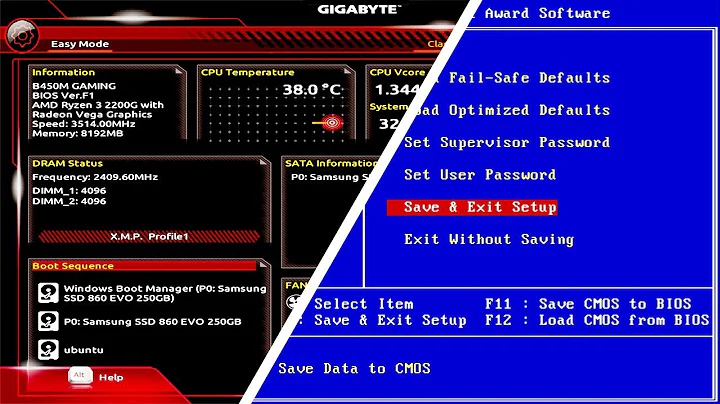Is there any way to boot to DOS in a system who's BIOS option is set to UEFI?
Solution 1
This is sort of an oxymoron. There are two standards for disk partition tables, MS-DOS and U/EFI. The older one is MS-DOS, the newer one is UEFI.
The old partition table type came with several serious shortcomings, the most famous of which is the inability to use disks larger than 2TiB. This comes from the fact that it uses 32-bit addresses to identify 512-byte sectors. The product of the two is 2TiB, the largest disk that you can use with this kind of partition table.
There are of course other limitations: Only 3 primary partitions, only 59 logical partitions, only one copy of the partition table (at the beginning of the disk, in the MBR), structured as a linked list which is obviously quite prone to corruption, the use of old-fashioned CHS (cylinder-Head-Ssector).
In order to overcome these problems, the GPT partition table has been introduced, as part of Intel's UEFI. The GPT overcomes all of these problems (for instance, there are two copies of the table, at the beginning and at the end of the disk, it allows the partitioning of much much larger disks, up to 9.4 ZiB, uses Logical Block Addressing LBA instead of CHS, has only primary partitions, up to 128).
The information of the partition table is store in a structure at the beginning of the disk, preceded by the Primary partition header (this is also replicated for redundancy at the end of the disk). This structure is new: it did not exist in the old MS-DOS partition table.
However, for safety reasons, this structure is preceded by a legacy MBR, i.e., the structure defining the partition table in the old MS-DOS scheme. This is done to protect the GPT from programs unaware of the new partition table (like fdisk, which you just used without compromising the disk).
Now you see why you can boot a pc from a disk with a GPT partiton table when you set the BIOS on BIOS mode: the disk does have a MBR, so you can boot off it. However, the converse is false: if the disk has a MS-DOS partition table (not the legacy/protective one I mentioned above, just the old-fashioned one not followed by a proper GPT structure), then, setting the BIOS to UEFI mode means that the booter will search for the GPT structure, which is instead missing.
This is why your question is a bit of an oxymoron.
Solution 2
No, it is not possible to boot to DOS while the option is set to "UEFI". Only UEFI compliant operating systems can be booted with this option.
Related videos on Youtube
Data Enthusiast
Updated on September 18, 2022Comments
-
Data Enthusiast almost 2 years
- I created a view by joining 4 other views - in same DB
- The 4 other views use tables from the same DB
- The new view has different schema from the base view
- the owner of all the schemas are same
- Provided select grant on the new schema to users
Users are able to see old views other than the one I created. What am I missing
-
 Admin almost 12 yearsDOS? Which version? I am not aware of a UEFI-aware version of MS-DOS, but I cannot speak for the other clones out there.
Admin almost 12 yearsDOS? Which version? I am not aware of a UEFI-aware version of MS-DOS, but I cannot speak for the other clones out there. -
Greg G. almost 12 years@Randolph - Just MS-DOS. I guess I don't know enough about UEFI, I was hoping that there would be some way to fool UEFI into booting MS-DOS. It sounds like that is not a possibility due to how EFI and DOS are structured.
-
Sparky_47 over 10 yearsOut of curiosity, what do you want to use DOS for?
-
 Julian Zucker almost 7 yearsWithout a MCVE, it's hard to help debug. Can you share a little more about your problem, like what views are being used, how users are viewing them, etc?
Julian Zucker almost 7 yearsWithout a MCVE, it's hard to help debug. Can you share a little more about your problem, like what views are being used, how users are viewing them, etc? -
Data Enthusiast almost 7 yearsThe view is a simple inner join of 4 other views and the users access it via sql server
-
Data Enthusiast almost 7 yearsSQL server is the dbms
-
MKR almost 7 yearsPlease share command you have used to grant access to users on view.
-
Ramhound over 8 yearsWithout clear instructions on how to implement the first method this answer isn't very helpful.
-
Data Enthusiast almost 7 yearsI had to drop and recreate the view and gray select again and it worked. query was fine , something was acting up... thanks for all your help


![Convert LEGACY Bios to UEFI Windows 10 Without Data Loss | Without Reinstalling Windows [2021]](https://i.ytimg.com/vi/t8Hklaw92IM/hq720.jpg?sqp=-oaymwEXCNAFEJQDSFryq4qpAwkIARUAAIhCGAE=&rs=AOn4CLDD6l3A-wBv_JZinbVGFLBmrWxQ9g)

